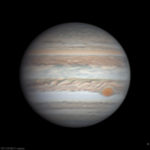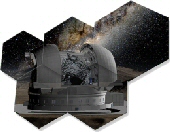Italiano (for English, please read further down):
E’ il periodo di maggior comodità per riprendere Giove e le calde serate di cielo sereno di questo periodo, anche se non significano cielo “stabile” alle alte quote, sono troppo comode per non provare a carpire i più piccoli dettagli dell’atmosfera gioviana.
Ecco un’altra immagine dello scorso giovedì 8 giugno, in condizioni di seeing (stabilità atmosferica) appena sufficienti a trarre informazioni più importanti per chi raccoglie e studia l’evoluzione atmosferica tramite le nostre immagini, frutto del nostro appassionato lavoro.
Questa immagine è una singola tricromia di 3 filmati da 90 sec. ciascuno per un totale di 4,5 minuti di ripresa. La Grande Macchia Rossa (GRS) volge al tramonto e a proposito di Macchia Rossa, l’11 luglio prossimo la sonda Juno passerà sopra di essa da pochissime migliaia di chilometri regalandoci, e svelandoci, i segreti ancora nascosti sulla sua morfologia ed evoluzione.
Grazie come sempre per la Vs. cortese attenzione e come sempre… ad maiora ! 😉
Dettagli tecnici: Celestron C14 StarBright ad F/27 – Baader-Zeiss barlow lens – Baader RGB filter set – PointGrey GS3-U3-32S4M-C camera – Seeing 5,5 – 6/10
in R band (610nm) – sito: Palermo centro @ my personal Observatory
English:
It’s Jupiter’s easier time here in Palermo and the warm evenings of the clear sky of this period, even if they do not mean “stable” jet stream at high altitudes, are too comfortable to try to capture the smallest details of the jovian atmosphere.
Here is another image of last thursday June 8th, in conditions of seeing just enough to get more information to study the evolution of the details in our images, the result of our passionate work.
This image is a single set of 90-second for each (R, G, B) channel imaging, for a total of 4.5 minutes of shooting. The Great Red Spot is towards the sunset, so I remember about it that on July 11, the Juno probe will pass over it from a few thousands of miles, giving and revealing the hidden secrets of its morphology and evolution.
Thank you always for your kind attention and as always … ad majora semper ! 😉
Technical details: Celestron C14 StarBright ad F/27 – Baader-Zeiss barlow lens – Baader RGB filter set – PointGrey GS3-U3-32S4M-C camera – Seeing 5,5 – 6/10 in R band (610nm) – sito: Palermo city @ my personal Observatory


